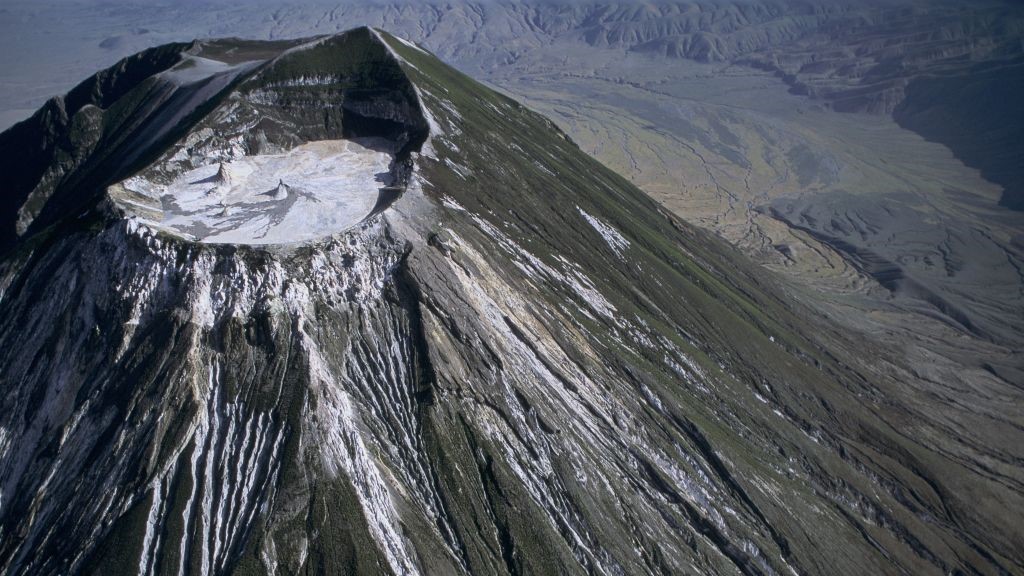
A volcano in Tanzania with magma that erupts like a garden hose has been steadily sinking into the ground for the past 10 years, a new study shows, and the cause could be a deflating reservoir directly beneath one of the volcano's two craters.
The new research reveals that the ground around the summit of Ol Doinyo Lengai volcano, which sits along an active rift zone in East Africa, subsided at a rate of 1.4 inches (3.6 centimeters) per year between 2013 and 2023. This means the 9,718-foot-tall (2,962 meters) volcano shrank by about 1.2 feet (36 cm) in the timeframe of the study, which was published June 8 in the journal Geophysical Research Letters.
Researchers used data from two satellite systems, Sentinel-1 and Cosmo-SkyMed, to produce maps showing changes over time in the ground around Ol Doinyo Lengai. Their maps indicate that a circular patch of ground around the volcano's northern crater was "moving away from the satellite with a steady rate of displacement over time," the researchers wrote in the study.
Ol Doinyo Lengai is the only known volcano on Earth that is actively erupting carbonatite magma — extremely runny magma that is saturated with alkali elements, such as calcium and sodium, and poor in silica. Most terrestrial magmas are rich in silica, a compound made from bonded chains of silicon and oxygen that binds molten rock together and gives it a viscous consistency. But unlike those other magmas, whose weight is between 45 and 70% silica, the magma that feeds Ol Doinyo Lengai contains less than 25% silica by weight, according to Erik Klemetti, a volcanologist and associate professor at Denison University in Ohio.
Related: Antarctica is covered in volcanoes, could they erupt?
"If you had to pick the most unique volcano on Earth, you'd be hard pressed to find a better candidate than Tanzania's Ol Doinyo Lengai," Klemetti wrote in a 2014 Wired article. The lava that comes out of Ol Doinyo Lengai is "some of the strangest stuff you'll ever see," he wrote, producing weird "garden hose" eruptions that leave behind white stains.
Carbonatite lava weathers differently than silicate lava due to its chemical makeup, Klemetti wrote. Calcium and carbon dioxide in the lava combine to make calcite and other carbonate minerals, which break down quickly in the presence of water or humidity. This means that although the lava is black or dark gray when it erupts, it quickly turns white once it dries, he wrote.
The magma that feeds Ol Doinyo Lengai is so runny, it should theoretically only produce eruptions characterized by lava flows. But in September 2007, the volcano, which at that point only had one crater, suddenly blasted open a second crater over 330 feet (100 m) deep in an area north of the summit. This explosive activity continued through spring 2008, after which the volcano resumed producing lava flows.
Previous research suggested the newly-blasted crater may be subsiding, and the new study confirms that the upper slopes of this crater have been sinking since 2013. (The researchers did not look at data between 2008 and 2013.) According to the authors, the likely cause for this subsidence is a deflating magma reservoir located 3,300 feet (1,000 m) beneath the volcano.
"The geometry and characteristics of the shallow magma plumbing system below Ol Doinyo Lengai remain elusive," they wrote in the study, but previous studies already hinted at a shallow reservoir.
This reservoir may be connected to a bigger magma storage area 9,900 feet (3,000 m) or deeper beneath the volcano, according to the study.
Monitoring the subsidence of Ol Doinyo Lengai is important to forecast eruptions, the researchers said. There is also a growing 330-foot-long lava-filled fissure along the western rim of the volcano that "could further elongate as Ol Doinyo Lengai continues to erupt and subside," they noted in the study.







